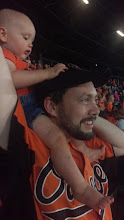Thursday night, while I was indulging in some silliness about Leo Gomez's baseball equipment, news leaked out about Melvin Mora's retirement. Of course, as I wrote back in July when the Diamondbacks released him, the writing was already on the wall. Still, I've been glad to read some favorable remembrances of his career from both O's-centric blogs and national blogs in the past few days. Here in Baltimore, we had the unhappy task of witnessing Melvin's decline, as his power dried up and he began grousing about attempts to drop him lower in the batting order and/or give him days off. But that shouldn't lessen his significant contributions to the team in his nine and a half seasons in Charm City.
His truly is an incredible story, as he signed with the Astros as a teenager in 1991 and played all over the field without much distinction before finally reaching the majors with the Mets in 1999. After a few seasons as a utility player with a passable bat in New York and Baltimore, he suddenly had an All-Star season with the Birds at age 31 in 2003, when he had a triple slash (AVG/OBP/SLG) of .317/.418/.503. Some second-half injuries limited him to 96 games and kept his counting stats down, but his .921 OPS was the highest among regulars on the team by a full 100 points. (The runner-up was the great Larry Bigbie...yeesh.) He was healthy enough to see action in 140 games in 2004, and the result was a career year: personal bests of 111 runs scored, 187 hits, 41 doubles, 27 home runs, 104 RBI, and a batting line of .340/.419/.562. That on-base percentage led the American League, and although he missed out on the All-Star Game, he did win the Silver Slugger in his first season as a regular third baseman. Looking back, it's almost inconceivable to me that Mora reached base nearly 42% of the time in those two seasons, especially since his OBP settled back into the .340s immediately afterward. But even at that lesser level of performance, he remained a solid offensive player for the next four seasons and a true member of the community, settling in Fallston with his wife and six children.
He left after 2009 with the most career games at third base for any Oriole not named Brooks Robinson, and is still ranked eighth in team history in Offensive Wins Above Replacement (26.0), tenth in games played (1,256), ninth in runs scored (709), tenth in hits (1,323), eighth in total bases (2,073), seventh in doubles (252), ninth in home runs (158), eighth in RBI (662), tenth in walks (465), eleventh in steals, surprisingly (82), second in hit-by-pitches (107)...well, you get the idea. Melvin Mora is a big part of Orioles history, and he's earned a happy and peaceful retirement.
































